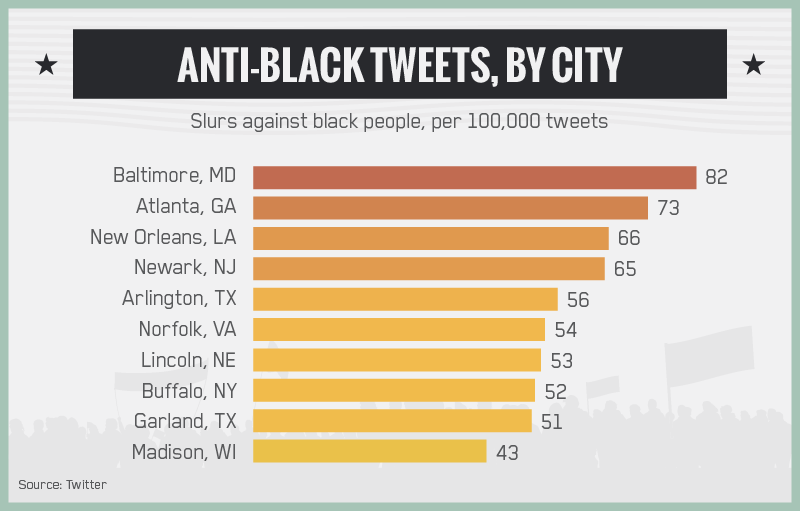Milwaukee Not Among Most Racist Cities
So says new study, which also ranks state as among the most tolerant in America.

Anti-Black Tweets, By City. Source Abodo
The idea that Milwaukee is among the most racist cities in America — something we have heard for decades — is based largely on one statistic, an analysis of how well distributed African Americans are throughout the metro area. But a new analysis of derogatory comments made on Twitter offers a different way to look into the hearts of minds of people in a given city.
Abodo, an apartment hunting site, analyzed 12 million tweets from June 2014 to December 2015 to find derogatory comments made about about different races, ethnicities, genders, religions, and sexual orientations and then ranked states and cities in various categories.
Milwaukee, a city always ranked as one of America’s ten most segregated cities, is not among the top ten when it comes to anti-black comments. Baltimore ranked first, with 82 slurs against black people per 100,000 tweets. Atlanta was second with 73 per 100,000 tweets and New Orleans with third, with 66 slurs. Interestingly, Madison, WI ranked 10th, with 43 anti-black tweets per 100,000.
Madison, however, looms as something of an exception within Wisconsin, as the state ranked among the lowest for anti-black tweets, closer to states like Idaho, with just 2.4 anti-black tweets per 100,000, followed by Maine with 2.7, and far below the worse states: West Virginia had 83.2 anti-black tweets per 100,000 tweets, followed by Maryland and Louisiana, with 36.5 and 31.3 per 100,000. (Wisconsin’s exact number is not divulged, but the color coded map suggests it falls near or below the midpoint.)
The cities with the most anti-Hispanic tweets were all in California and Texas, except for Miami, which ranked ninth worst. California and Texas were also two of the worst states in anti-Hispanic tweets, along with Nevada, Arizona and New Mexico. In short, regions with heavier populations of Hispanics had more slurs used via Twitter.
Buffalo led the way in anti-gay tweets and most of the other cities in the top ten were again in those surly states of California (five cities, led by Riverside) and Texas (two cities, led by Arlington).
Part of this could reflect different cultural patterns as to how common derogatory language of any kind is used: Thus, Louisiana had far and away the most derogatory tweets of all kinds, with 1155 per 100,000, versus just 298 per 100,000 in Wisconsin, which ranked tenth best in the least derogatory language on Twitter.
Still, the states using the most derogatory language in general weren’t necessarily the states using the most anti-black, anti-gay or anti-Hispanic language on Twitter.
Moreover, the findings about Wisconsin and Milwaukee seem to be echoed by a study of where the N-word is most likely to be used in Google searches: Wisconsin largely ranked near the average in use of the N-word, and that included southeast Wisconsin. “The most concentrated cluster of racist searches happened not in the South, but rather along the spine of the Appalachians running from Georgia all the way up to New York and southern Vermont,” the Washington Post reported. “Other hotbeds of racist searches appear in areas of the Gulf Coast, Michigan’s Upper Peninsula, and a large portion of Ohio.”
Now you could argue that its absurd to rank the racism of cities or states based merely on how many racist-sounding tweets or google searches are done. But it’s arguably just as simplistic to use one statistic, the dissimilarity index, which measures how well distributed black residents are in a metro area, to condemn some cities as segregated and others as more progressive.
Using this approach, Milwaukee’s four-county metro area, which is 17 percent black, falls short of racial perfection in any census tract that is less — or more — than 17 percent black. Thus, census tracts that are 10 percent, 25 percent, 40 percent or 60 percent black are all considered unacceptable, though many people of both races might consider any of these to be integrated.
Under the approach used by the dissimilarity index, it doesn’t matter if a city actually has few blacks living there, so long as they are well-distributed. Thus very white metro areas like Salt Lake City (1 percent black) or Lincoln, Nebraska (2.7 percent black) have traditionally ranked as the least segregated. That makes little sense to me, and it’s worth noting that Lincoln ranks seventh worst among American cities in anti-black tweets. So does this mean Lincoln is more or less racist than other cities?
Much of the Great Migration of African Americans from the South was to northern cities, which now have some of the largest black populations. Yet these very cities, that also often have large Hispanic populations, end up being rated as most segregated using the dissimilarity index, while largely white cities get good rankings.
A recent ranking by Priceonomics flips this on its head, giving cities credit for being diverse places. Its analysis ranks Milwaukee as the 11th most diverse city in the nation, with Oakland ranked as most diverse. Milwaukee is also ranked as 34th least segregated among the 45 biggest cities; not a great ranking but far better than the segregated hellhole its been assumed to be for the last half century, as sociologists rolled out their simplistic dissimilarity index every ten years. (That includes the absurd designation of “hypersegregation,” which continues to be used by some though it is quite meaningless.)
I don’t mean to suggest Milwaukee doesn’t have racial problems. It clearly does. But the idea that this city is uniquely toxic in that respect — based on a single statistical ranking — is nonsense. A more nuanced and accurate way of viewing Milwaukee was suggested by the newly created “distress score” which ranked economic distress for all zip codes in America. The index found that neither the city nor county of Milwaukee was among the worst in the nation for “spatial inequality” but our metro area ranked among the worst.
Milwaukee faces many of the same problems as other big cities and has a long way to go in assuring equity for all. But it is probably ahead of many cities in some areas (for instance in reducing lead poisoning or infant mortality in poor, heavily black neighborhoods) and well-behind in other areas (incarcerating too many blacks and failing to create transportation links between central city workers and jobs). Rather than beating up on ourselves for the bogus label of most segregated city, we might be better off attacking the obvious issues of equity we face.
Murphy's Law
-
National Media Discovers Mayor Johnson
 Jul 16th, 2024 by Bruce Murphy
Jul 16th, 2024 by Bruce Murphy
-
Milwaukee Arts Groups in Big Trouble
 Jul 10th, 2024 by Bruce Murphy
Jul 10th, 2024 by Bruce Murphy
-
The Plague of Rising Health Care Costs
 Jul 8th, 2024 by Bruce Murphy
Jul 8th, 2024 by Bruce Murphy





















When using Twitter as a way to measure racism, it’s important to remember demographics. Only 16% of Twitter users are age 50 and above. There’s a whole lot of racist people age 50 and above.
Hang on, is this data simply measuring the number of times the N-bomb shows up in a tweet? Because if it is it’s going to skew to areas with larger African American populations anyway. Because every time someone uses it in a hip hop or cultural context (one African American to another for example) its going to show up.
This could say more about the demographics of tweeters in Milwaukee than anything else.
For a short ten months, I lived in Mandeville, La This quaint little suburb of New Orleans, located on the Northshore of Lake Ponchartrain. The first stop on the famous Causeway. It is equivalent to any of the Milwaukee WOW counties. It’s where the white people live. To be fair, some people moved there post-Katrina.
In my experience with Southerners is their born and breed politeness is the glazing on the sweet bread of their fear and dislike of blacks and Hispanics they don’t know.
On one hand, they tell you the New Orleans could have never recovered from the disaster that Katrina inflicted on them without the Hispanic migrant workers and on the other, freely admit they don’t want to live with them.
They have all of the code works for their fear of life in New Orleans and their justification for moving to the Northshore. (For many of them this means the fifty-mile commute over the causeway to get to work.) It’s not the people; it’s the crime. It’s not the cost of living; it’s the schools.
Once many of these gentle church going folks, get to know you they will let their fear and loathing of the other seep out like a slow leak in a tire.
In short, they are different in their approach, but in reality no different in their racist feelings than we northerners are.
First, I don’t understand how anyone can claim that an aggregation of tweets is an accurate measure of racism.
Secondly, and more importantly, even if Milwaukeeans aren’t explicitly racist, this says nothing of implicit racism or structural racism, both of which are quite apparent in Milwaukee.
This reads like someone wanting a win so bad that they’ll take whatever they can get, even if it’s nonscientific nonsense. We need to actually address the issues of race in this city, not hide behind how supposedly progressive we are according to some asinine survey.
Tweeting as an empirical measure of racism, left undefined?
Karl Taeuber would be appalled, as would Isabel Wilkerson, or anyone else looking for rigor and validity in empirical investigations.
You do understand that housing discrimination is not some relic, but a living embodiment of racism?
Just a thought, but perhaps a social scientific investigation of the black population’s opinion as an measure of anti-black racism might yield some some instructive results.
Does this control for blacks using the n word as its’ reclaimed meaning? Because I can’t help but notice that a lot of the top cities listed are chocolate cities…
We spend winters in the south visiting a number of places that have bike trails. (BTW, most of the southern trails are much better than those in Wisconsin. They are all paved and they are all free. Those people who think the Elroy-Sparta is the best just haven’t experienced other trails. Yes, tunnels are nice. Just ride the trails in Minnesota to see something better.)
We’ve been spending some time in Mandeville every winter and I agree with what Jeff says above. A few years ago some guy “selling” insurance, maybe State Farm, had a really bad anti-Obama sign outside his place in the Mandeville area. (I don’t understand why people put political signs outside their businesses. Why drive away business? Dad owned a taven when we were kids and allowed everyone to post their 8″x10″ signs on his window.)
We stay in Mississippi and bike on the Longleaf Trace, probably one of the real top ten trails in the US, and I rode off the trail one day in the small town of Bassfield. I went past a home, young couple outside, shed door was open. There was a “man cave” sign over the door. But also a Nazi swastika. I’m sure they would say that was a joke.
Then of course they have the Confederate Battle Flag as part of the Mississippi State Flag.
The Longleaf Trace goes through 3 counties, Forrest, Lamar, and Jeff Davis. Every educated person knows who Jefferson Davis was. But Forrest? That is named for Nathan Bedford Forrest, a Confederate general, who was the first Grand Wizard of the KKK after the Civil War.
I worry that data crunching about racism (regardless of the stats) simply continues to keep the issues at a comfortable distance for white people. Does it matter whether MKE is viewed as among the absolute worst–or just really bad–cities for inequity and racism?
As a white person who interacts somewhat within the black community, it seems that many people have given up thinking about long-time problems within the city. Poverty, crime, failing schools, lack of jobs and good transportation, hopelessness, mass incarceration, etc. are viewed as “inner-city issues.” The problems seem insurmountable, so tuning them out becomes a coping reaction. It’s easier to stop caring when it seems we might have little impact even if we try to address them. Why bother? Except most people living in the central city cannot tune out these realities, nor easily overcome daunting obstacles.
I don’t have answers. I just wish this city did not seem so stuck in ruts. What else can we do besides crunch data—or whistle Dixie?
There are a lot of ways to measure racism, and some combination of metrics is probably the best way to handle it. As others have said, Twitter is not an ideal way to do this.
I was thrilled to read this article. I am a transplant to Wisconsin (Mke-area) and so I have a clearer perspective than locals about some of Milwaukee’ problems. My husband and I both knew that the claim that Milwaukee was the most racist city in the country (or close to the most racist) was incorrect. And we found it odd that people wore the myth like a badge and even fought for the truth of it, when we saw no truth in it at all. A very important fact to remember is that the belief in that myth is what will pull Milwaukee down. We need to be very careful about what we choose to believe, because belief (in anything) is the engine that perpetuates a myth. So, now it’s out into the open. Good! I love it when destructive myths come into the light of truth. Good article.
Yes, there is racism and it’s a miserable reality for many people because it creates a great deal of pain and separation and suspicion and hatred. Once people hate, the ball game is over. When those who are hated are pushed down and blamed and reviled, how can they ever rise up? They naturally sink lower, especially when poverty is involved. Hatred is a destructive force. And so, here we are today, reaping the results of our hatred in Brussels, Paris, the Middle East, our United States, etc. Humanity’s hatred is coming out of the darkness and being shoved in our faces. Why? So we can clean up the hatred in ourselves first, which will eventually clean up the world. Love yourself first and be kind to others. Start small, little by little, until it snowballs
I am now stepping off my soapbox. Namaste
I’m not sure how this is supposed to work. If I tweet sometning on a Madison site which is considered racist, and I don’t live in Madison does it count as a Madison racist tweet?
Bruce: It’s the MIlwaukee metro region that’s the most segregated (or among the worst segregated) by race in the country, not the City itself.
Dennis, yes, as I’ve written the dissimilarity index looks at metro areas, but when its results are reported it’s the Milwaukee name that gets shamed nationally and internationally, and you will find all sorts of assumptions made about the city (indeed you’ll find them in comments after some of our stories) being racist even while it is the most diverse place in the state. I’m trying to suggest a more nuanced view is needed.
This is a thought provoking piece because it considers factors other than the strictly geographical. I lived in Seattle in the 1970’s. That city had what was called “The Central District.” When I moved to Milwaukee in the 80’s, I noticed similarities between Seattle’s CD and what was called “the core” in Milwaukee. I do not recall Seattleites being as self-critical on this issue as Milwaukeeans are. I applaud the expansion of the discussion of de-facto, institutional and others forms of segregation to include more factors.
Very interesting. And though obviously any of these measures of racism is incomplete, including geography, it does put some perspective on the “one of the most racist cities in America” label that I’ve heard for years.
I was disgusted to read this thoughtless article.
It is more useful, more rational, more helpful, and more possible to carefully quantify (and rank, if necessary) racial disparity and racial injustice than it is to try to rank “racism”. And Wisconsin and the Milwaukee Metro area indisputably rank among the very worst states and metro areas in the nation in the many peer-reviewed studies of racial disparity and racial injustice, including but not limited to racial disparity in housing, in education, in health care, in infant mortality, in incarceration rates, in childhood poverty, in voting rights and opportunities, in employment. These words weren’t even mentioned in this article.
This extremely poor and thoughtless article sets up a straw man by first assuming and implying that something the author calls “segregation” is synonymous with the many manifestations of racial injustice, and then asserting that something he calls (but does not define) “racism” is a better problem for us to focus upon than his “segregation” straw man, and finally absurdly and outrageously employing the counting of twitter usage of racially disparaging language elements as an acceptable, credible metric to quantify regional or community racism.
Why do some people continue to believe that ignoring a festering wound, and pretending that it isn’t really there, and reinforcing appalling ignorance and apathy, does not make things better?
The word that Murphy used to describe the straw man that he set up and attacked, is best applied to the article, itself. It’s worthless “nonsense”.
My preceding comment contains a mistake in the first sentence of the last paragraph. The sentence should read, “Why would anyone continue to believe that it’s best to ignore a severe and festering wound, pretend that it isn’t really there, and reinforce appalling public ignorance and apathy?”